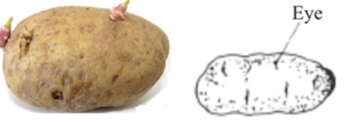Science > Biology > Botany> Morphology of Plants > Modification of Stem
In this article, we shall study the modification in stem in some plants for performing the functions other than its primary function. Primary functions of the stem are
- To support and orient the leaves in a manner that they are exposed to maximum sunlight and for efficient gaseous exchange during photosynthesis and respiration.
- To conduct water and minerals from roots to leaves and manufactured food from leaves to different parts of the plant.
- To bear flowers and fruits
Some stems perform the function of storage of food, support, protection, and vegetative propagation. The secondary functions of the stem are
Underground Modification of Stem:
Since underground, they may seem like roots but they have characteristics of the stem, like the presence of nodes and internodes, scaly non-green leaves and buds. This modification serves two functions it acts as perennating structures by remaining leafless and dormant in winter but giving off aerial shoots under favourable conditions (next season) and Store food and become thick and fleshy.
Rhizome:
It is a prostrate, dorsoventrally thickened brownish stem, which grows horizontally under the surface of the soil. It shows distinct nodes and internodes. It shows distinct nodes and internodes. It bears scale leaves on nodes, It possesses terminal bud and axillary buds in the axil of each scale-leaf present at the node. Adventitious roots are present. e.g. Ginger (अद्रक), Turmeric (हलदी).

Stem Tuber:
Tubers are actually the swollen tips of ends of special underground branches swollen due to the storage of food as starch. The tubers show nodes and internodes. Nodes bear scale leaves with axillary buds, commonly called eyes. Under favourable conditions eyes sprout and produce aerial roots. Thus tubers help in vegetative propagation. They do not produce adventitious roots. e.g. Potato (आलू).

Bulb:
It is a condensed disc like an underground stem. The upper surface of the disc-like stem is conical and bears centrally placed apical bud and many concentrically arranged overlapping scale leaves. Scale leaves store food. When the scale leaves surround the apical bud in the form of concentric rings, it is called a tunicated bulb. The lower surface of the stem produces adventitious roots. e.g. onion (प्याज).

When the scale leaves partially surround the apical bud by overlapping each other, it is called a scaly bulb. The lower surface of the stem produces adventitious roots. e.g. garlic (लहसुन).

Corm:
It is condensed disc-like underground, fleshy, spherical stem with flattened base, It grows vertically, bears many scale leaves, distinct nodes and internodes, buds and adventitious roots. e.g. Saffron (केसर), yam (जिमीकंद), gladiolus.

Sub Aerial Modification Of Stem:
Stems are weak, therefore lie prostrate on the ground or may get partially buried in the upper layer of soil. The plants bearing such stems are called creepers. Their stems serve the function of vegetative propagation.
Runner:
The basal internodes of the bud elongate horizontally and trail along the soil carrying the bud to a distance from the mother plant where it gets fixed to the soil by means of adventitious roots and develops a new daughter plant. This branch carrying the bud is called a runner. It grows in all the direction and a single plant soon covers a large area by its progeny. e.g. Grass, Oxalis, Centella asiatica, strawberry, etc.

Stolon:
When a weak lateral branch which grows upwards then arches down to meet the soil, strike roots and produce daughter plants. The difference between the runner and stolon is, runner grows horizontally, while stolen grow obliquely upward and then arches to the ground. e.g. Mint (‘Pudina’), Jasmine.

Offset:
Like runner but thicker and shorter, grow for a short distance then produce cluster (rosette) of leaves above and adventitious roots below; generally in aquatic plants. It is just like the runner, only it is shorter and thicker. e.g. water hyacinth (Eichhornia crassipes), pistia (Pistia stratiotes), water lettuce

Sucker:
An underground runner that grows horizontally for a distance under soil then emerges obliquely upwards, strikes roots and forms daughter plants. e.g. Chrysanthemum, Mentha arvensis, banana, pineapple etc.

Aerial Modification of Stem:
The whole stem or its part (axillary or terminal bud) gets modified to perform definite functions. It is a stem because they show characteristics like a) Arise in the axil of leaf b) Bear nodes and internodes c) may bear leaves, buds, flowers.
Stem Tendrils:
Stem or its branches get modified into green threadlike, spirally coiled leafless structures called tendrils which are meant for climbing. They twine around neighbouring objects and help weak plants to climb. These may be branched or unbranched. A scale leaf is always present at the point of branching of the tendril. e.g. Grapevine, cucumber, pumpkins, watermelon, etc.

Thorns:
These are straight, pointed, hard or woody structures sometimes they bear leaves, flowers or may be branched. Axillary buds of stems get modified into thorns (e.g. Citrus, Duranta, and Aegel). In Carrissa, terminal buds get modified into thorns. Thorns are used as organs of defence against grazing animals or climbing (e.g. Bougainvillea) and to check transpiration.

Phylloclade:
These are fleshy, green flattened or cylindrical branches of unlimited growth with nodes and internodes. The leaves are modified into spines or scales to check transpiration. This modification of stem is observed in plants growing in dry regions. The stem takes part in photosynthesis and stores water. e.g. Opuntia, Euphorbia, Casuarina, Cocoloba etc.

Cladode or Cladophylls:
It is a phylloclade with limited growth i.e. with only one or two internodes; help in photosynthesis. These are a green cylindrical or flattened leaf-like branches. In Asparagus, the cladodes are one internode long and in Ruscus, the cladodes are two internodes long. They help in photosynthesis.

Bulbil:
These are modified vegetative or floral buds with stored food and meant for vegetative propagation. In Dioscorea, bulbils are condensed axillary buds while in Agava and lily the floral buds develop into bulbil. They detach to develop into a new plant.

One reply on “Modification of Stem”
Nice information